高考英语专项学案---动词的时态和语态
高考英语动词及动词短语精讲教案
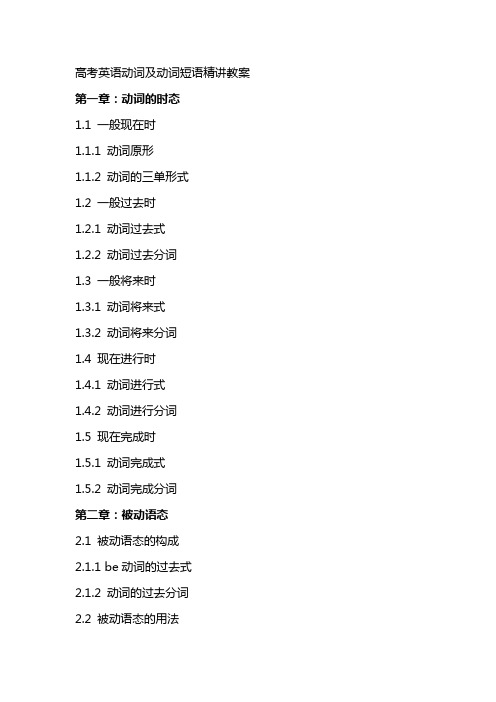
高考英语动词及动词短语精讲教案第一章:动词的时态1.1 一般现在时1.1.1 动词原形1.1.2 动词的三单形式1.2 一般过去时1.2.1 动词过去式1.2.2 动词过去分词1.3 一般将来时1.3.1 动词将来式1.3.2 动词将来分词1.4 现在进行时1.4.1 动词进行式1.4.2 动词进行分词1.5 现在完成时1.5.1 动词完成式1.5.2 动词完成分词第二章:被动语态2.1 被动语态的构成2.1.1 be动词的过去式2.1.2 动词的过去分词2.2 被动语态的用法2.2.1 表达动作的承受者2.2.2 强调动作的承受者2.3 被动语态的转换2.3.1 将主动语态转换为被动语态2.3.2 将被动语态转换为主动语态第三章:情态动词3.1 can和may3.1.1 表示能力3.1.2 表示请求3.2 must和have to3.2.1 表示必须3.2.2 表示需要3.3 shall和will3.3.1 表示承诺3.3.2 表示意愿3.4 should和ought to3.4.1 表示应该3.4.2 表示建议第四章:动词短语4.1 动词+副词4.1.1 举例:look after,run quickly 4.2 动词+介词4.2.1 举例:put on,go to4.3 动词+名词4.3.1 举例:make a decision,take a picture 4.4 动词+动词4.4.1 举例:try to do,help with第五章:动词辨析5.1 动词词义辨析5.1.1 举例:see-watch,read-study5.2 动词搭配辨析5.2.1 举例:make-have,get-obtn5.3 动词时态辨析5.3.1 举例:go-went,do-did第六章:动词的语态6.1 主动语态6.1.1 动词原形6.1.2 动词的进行式6.2 被动语态6.2.1 be动词的过去式6.2.2 动词的过去分词6.3 语态的转换6.3.1 主动语态转换为被动语态6.3.2 被动语态转换为主动语态第七章:情态动词的用法7.1 can和may7.1.1 表示能力7.1.2 表示请求7.2 must和have to7.2.1 表示必须7.2.2 表示需要7.3 shall和will7.3.1 表示承诺7.3.2 表示意愿7.4 should和ought to7.4.1 表示应该7.4.2 表示建议第八章:动词短语的辨析8.1 动词+副词8.1.1 举例:look after,run quickly8.2 动词+介词8.2.1 举例:put on,go to8.3 动词+名词8.3.1 举例:make a decision,take a picture 8.4 动词+动词8.4.1 举例:try to do,help with第九章:动词辨析与应用9.1 动词词义辨析9.1.1 举例:see-watch,read-study 9.2 动词搭配辨析9.2.1 举例:make-have,get-obtn 9.3 动词时态辨析9.3.1 举例:go-went,do-did9.4 动词在特定语境中的应用9.4.1 举例:put off,make up第十章:动词综合练习10.1 动词填空练习10.1.1 选择合适的动词形式填空10.1.2 根据语境选择正确的动词时态10.2 动词短语选择练习10.2.1 根据语境选择合适的动词短语10.2.2 改写句子,使用不同的动词短语10.3 动词辨析练习10.3.1 选择正确的动词10.3.2 根据语境选择合适的动词形式第十一章:动词与介词的搭配11.1 常见介词与动词的搭配11.1.1 举例:get up,put down11.2.1 表示位置关系11.2.2 表示动作方向11.3 动词与介词搭配的练习11.3.1 根据语境选择合适的介词11.3.2 完成句子,使用给定的动词和介词第十二章:动词与副词的搭配12.1 常见副词与动词的搭配12.1.1 举例:run quickly,speak loudly 12.2 动词与副词搭配的意义12.2.1 表示程度12.2.2 表示方式12.3 动词与副词搭配的练习12.3.1 根据语境选择合适的副词12.3.2 改写句子,使用不同的副词第十三章:动词与名词的搭配13.1 动词与名词搭配的类型13.1.1 动宾搭配13.1.2 动状搭配13.2 动词与名词搭配的意义13.2.1 表示动作的对象13.2.2 表示动作的状态13.3.1 根据语境选择合适的名词13.3.2 完成句子,使用给定的动词和名词第十四章:动词与形容词的搭配14.1 动词与形容词搭配的类型14.1.1 动词+形容词作宾语14.1.2 动词+形容词作状语14.2 动词与形容词搭配的意义14.2.1 表示主语的状态14.2.2 表示动作的特点14.3 动词与形容词搭配的练习14.3.1 根据语境选择合适的形容词14.3.2 改写句子,使用不同的形容词第十五章:动词综合应用15.1 动词在不同语境中的应用15.1.1 口语交流15.1.2 书面表达15.2 动词短语的创造性使用15.2.1 改写句子,使用不同的动词短语15.2.2 创作短文,运用所学动词和短语15.3 动词复习与测试15.3.1 完成填空题15.3.2 解答选择题重点和难点解析1. 动词的时态:一般现在时、一般过去时、一般将来时、现在进行时和现在完成时。
(完整版)高三英语复习教案:动词时态和语态
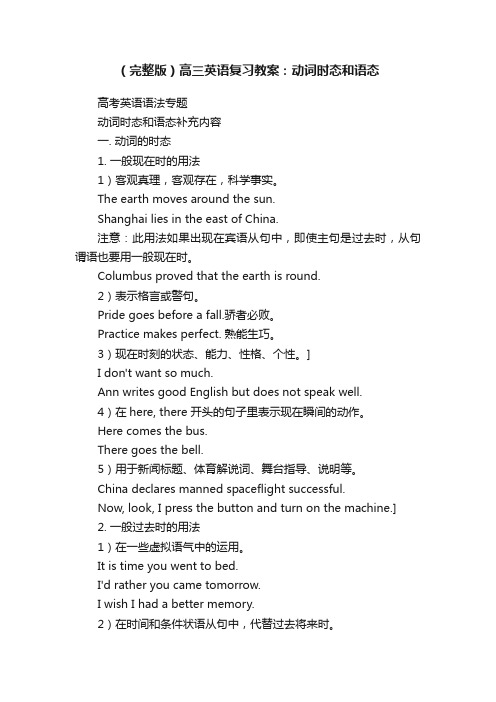
(完整版)高三英语复习教案:动词时态和语态高考英语语法专题动词时态和语态补充内容一. 动词的时态1. 一般现在时的用法1)客观真理,客观存在,科学事实。
The earth moves around the sun.Shanghai lies in the east of China.注意:此用法如果出现在宾语从句中,即使主句是过去时,从句谓语也要用一般现在时。
Columbus proved that the earth is round.2)表示格言或警句。
Pride goes before a fall.骄者必败。
Practice makes perfect. 熟能生巧。
3)现在时刻的状态、能力、性格、个性。
]I don't want so much.Ann writes good English but does not speak well.4)在here, there 开头的句子里表示现在瞬间的动作。
Here comes the bus.There goes the bell.5)用于新闻标题、体育解说词、舞台指导、说明等。
China declares manned spaceflight successful.Now, look, I press the button and turn on the machine.]2. 一般过去时的用法1)在一些虚拟语气中的运用。
It is time you went to bed.I'd rather you came tomorrow.I wish I had a better memory.2)在时间和条件状语从句中,代替过去将来时。
Mother said I couldn’t watch TV before my homework was finished.3)情态动词could, would表示委婉语气。
Could you lend me your bike?Would you help me?4) used to do/ wouldused to do “过去常常”,表示过去习惯性的动作或状态。
2024高考英语语法知识点归纳总结动词的时态和语态
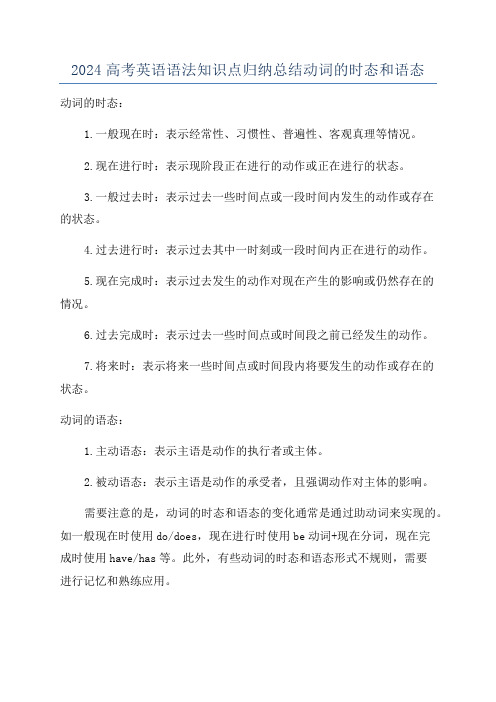
2024高考英语语法知识点归纳总结动词的时态和语态
动词的时态:
1.一般现在时:表示经常性、习惯性、普遍性、客观真理等情况。
2.现在进行时:表示现阶段正在进行的动作或正在进行的状态。
3.一般过去时:表示过去一些时间点或一段时间内发生的动作或存在
的状态。
4.过去进行时:表示过去其中一时刻或一段时间内正在进行的动作。
5.现在完成时:表示过去发生的动作对现在产生的影响或仍然存在的
情况。
6.过去完成时:表示过去一些时间点或时间段之前已经发生的动作。
7.将来时:表示将来一些时间点或时间段内将要发生的动作或存在的
状态。
动词的语态:
1.主动语态:表示主语是动作的执行者或主体。
2.被动语态:表示主语是动作的承受者,且强调动作对主体的影响。
需要注意的是,动词的时态和语态的变化通常是通过助动词来实现的。
如一般现在时使用do/does,现在进行时使用be动词+现在分词,现在完
成时使用have/has等。
此外,有些动词的时态和语态形式不规则,需要
进行记忆和熟练应用。
高考复习学案-动词时态语态的基本结构和用法
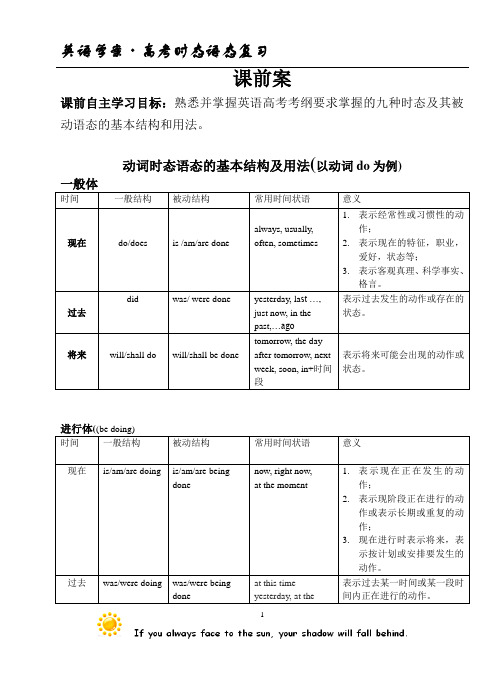
课前案课前自主学习目标:熟悉并掌握英语高考考纲要求掌握的九种时态及其被动语态的基本结构和用法。
动词时态语态的基本结构及用法(以动词do为例)1(have done)2课堂案时态语态题的解题思路1.这个动作可能发生在什么时间?题干中可参照的时间信息有哪些?2.这个动作处于什么状态?是进行中, 还是已结束(完成)?3.这个动作与主语的关系,是主动还是被动?直击高考Part1. 用括号内单词的正确形式填空。
1.时态语态题在语法填空中的考查语法填空题提示词为动词时,若句中没有谓语动词,或者虽然已有谓语动词,但需填的动词与之是并列关系时,所给动词就是谓语动词,就要考虑时态语态。
1.I feel so excited! At this time tomorrow morning I ________(fly) to Shanghai.(2012辽宁)2.—Do you think Mom and Dad ________ (be) late?—No, Swiss Air is usually on time.(2013北京高考)3.Bob called to tell his mother that he couldn’t ent er the house, for he __________ (leave) his key at school.(2013上海高考)4.Hurry up, kids! The school bus __________ (wait) for us.(2013四川高考)5.I felt very tired when I got home, and I __________ (go) straight to bed.(2013重庆高考)6. During the last three decades, the number of people participating in physical fitness programs__________(increase)sharply.(2013浙江)7.—Tony, why are your eyes red?—I__________ (cut) up peppers for the last five minutes. (2014江西卷)8. Yangshuo ______ (be) really beautiful. (2015全国I卷)3Part2. 单句改错。
高三英语动词的时态和语态教案
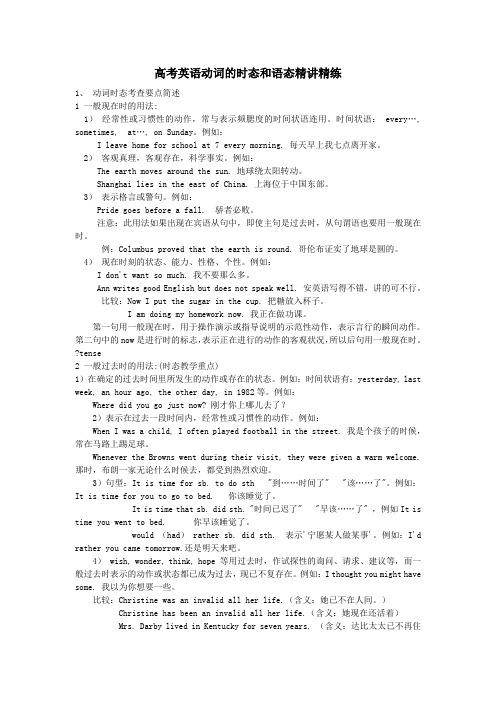
高考英语动词的时态和语态精讲精练1、动词时态考查要点简述1 一般现在时的用法:1)经常性或习惯性的动作,常与表示频腮度的时间状语连用。
时间状语: every…, sometimes, at…, on Sunday。
例如:I leave home for school at 7 every morning. 每天早上我七点离开家。
2)客观真理,客观存在,科学事实。
例如:The earth moves around the sun. 地球绕太阳转动。
Shanghai lies in the east of China. 上海位于中国东部。
3)表示格言或警句。
例如:Pride goes before a fall. 骄者必败。
注意:此用法如果出现在宾语从句中,即使主句是过去时,从句谓语也要用一般现在时。
例:Columbus proved that the earth is round. 哥伦布证实了地球是圆的。
4)现在时刻的状态、能力、性格、个性。
例如:I don't want so much. 我不要那么多。
Ann writes good English but does not speak well. 安英语写得不错,讲的可不行。
比较:Now I put the sugar in the cup. 把糖放入杯子。
I am doing my homework now. 我正在做功课。
第一句用一般现在时,用于操作演示或指导说明的示范性动作,表示言行的瞬间动作。
第二句中的now是进行时的标志,表示正在进行的动作的客观状况,所以后句用一般现在时。
?tense2 一般过去时的用法:(时态教学重点)1)在确定的过去时间里所发生的动作或存在的状态。
例如:时间状语有:yesterday, last week, an hour ago, the other day, in 1982等。
例如:Where did you go just now? 刚才你上哪儿去了?2)表示在过去一段时间内,经常性或习惯性的动作。
高三英语语法复习教案-动词时态语态

高三英语语法复习教案-动词时态语态【时态的基本概念】时态是表示谓语动作时间概念的动词形式。
英语中的时态专指谓语动词而言,不同时间概念的谓语动作有不同的时态,每一个时态又有各自不同的动词形式。
高中阶段要求学生熟练掌握八种时态,此外现在完成进行时在高中教材中反复出现,也应列入"应知应会"的范围。
1.一般现在时:经常发生的动作或规律性的动作。
Each person needs water and a diet of healthy food. (P.2, Senior Book1B)The moon travels round the earth once every month. (P. 8, Senior Book2B)在时间状语从句和条件状语从句中,用一般现在时表示将来的概念。
引起时间状语从句的连词有:when, after, before, until, as soon as;引起条件状语从句的连词有:if, unless; so(as)long as。
I will not stop my fight against slavery until all slaves are free. (P.52, Senior Book1A)2.一般过去时:过去发生过了的动作,这个动作的全过程已经结束。
诸如yesterday, last……ago都是典型的一般过去时的时间状语。
Fortunately, I was in time for the interview. (P.34, Senior Book2B)The interview went well and I told the company about my experiences and answered their questions as honestly as I could. (P.34, Senior Book2B)3.一般将来时:将要发生的动作。
高考英语一轮复习《动词的时态与语态》教案新人教版

英语16种时态二、常见时态的基本用法一般现在时一般现在时是描述现在或经常性的动作性质或状态的时态。
(常和every time, now and then, occasionally, often, seldom, sometimes, usually等连用)具体用法:1)表示经常性或习惯性的动作。
We Beijing.4)表示已经“列入日程”的将来的事件,尤其指计划中的和安排好的将来的动作,这些动词往往表示“出发,到达”等含义的词,如,arrive, begin, go, leave, start, stay等。
The train arrives at 10:30. There's plenty of time. 。
考点一:表示永恒的真理,即使出现在过去的语境中,仍用一般现在时。
如:I learned that the earth goes around the sun when I was in primary school.考点二:在时间和条件状语从句中,一般现在时表将来;常用的引导词有:时间:when, until, after, before, as soon as, once, the momentthe minute, the day;条件:if, unless, provided.If .If it rains tomorrow,I shall stay at as she arrives.一般过去时一般过去时表示过去发生的动作、存在的状态,或反复发生的动作,句中一般都有表示过去具体时间的时间状语。
具体用法:1)表示在过去特定时间中一次或一度发生的动作或存在的状态。
a. 有明确的过去时间:yesterday,last night,…ago, just now, in 1980, in the past…b. 对比现在 Scientists think that the continents weren’t always where they are today.c. 其他暗示 He could I was a child, I often played football in the street.3)用在条件句中表示与现在或将来事实不符的虚拟语气。
动词时态和语态教案

动词时态和语态教案第一章:引言1.1 目的:让学生了解动词时态和语态的概念及其重要性。
1.2 内容:动词时态的概念和分类动词语态的概念和分类1.3 教学方法:讲授法:讲解动词时态和语态的概念及分类互动法:引导学生举例说明和练习第二章:动词的现在时态2.1 目的:让学生掌握现在时态的用法和构成。
2.2 内容:现在时态的定义和分类现在时态的构成和用法2.3 教学方法:讲授法:讲解现在时态的定义、分类和构成练习法:让学生通过练习题巩固现在时态的用法第三章:动词的过去时态3.1 目的:让学生掌握过去时态的用法和构成。
3.2 内容:过去时态的定义和分类过去时态的构成和用法3.3 教学方法:讲授法:讲解过去时态的定义、分类和构成练习法:让学生通过练习题巩固过去时态的用法第四章:动词的将来时态4.1 目的:让学生掌握将来时态的用法和构成。
4.2 内容:将来时态的定义和分类将来时态的构成和用法4.3 教学方法:讲授法:讲解将来时态的定义、分类和构成练习法:让学生通过练习题巩固将来时态的用法第五章:动词的被动语态5.1 目的:让学生掌握被动语态的用法和构成。
5.2 内容:被动语态的定义和分类被动语态的构成和用法5.3 教学方法:讲授法:讲解被动语态的定义、分类和构成练习法:让学生通过练习题巩固被动语态的用法第六章:动词的进行时态6.1 目的:让学生掌握进行时态的用法和构成。
6.2 内容:进行时态的定义和分类进行时态的构成和用法6.3 教学方法:讲授法:讲解进行时态的定义、分类和构成练习法:让学生通过练习题巩固进行时态的用法第七章:动词的完成时态7.1 目的:让学生掌握完成时态的用法和构成。
7.2 内容:完成时态的定义和分类完成时态的构成和用法7.3 教学方法:讲授法:讲解完成时态的定义、分类和构成练习法:让学生通过练习题巩固完成时态的用法第八章:动词的完成进行时态8.1 目的:让学生掌握完成进行时态的用法和构成。
高考英语动词时态和语态

高考英语动词时态和语态I.要点1、一般现在时(1)表示经常发生的动作或现在存在的状态,常与sometimes, always, often, every day 等时间状语连用。
如:Sometimes, we go swimming after school.(2)表示客观真理、科学事实等。
如:The earth goes round the sun.2、现在进行时(1) 表示说话时或现阶段正在进行的动作,常与now, at present等时间状语连用。
如:What are you doing now?(2) 和always, continually等连用,表一种经常反复的动作,常含有某种情感。
如:He is always doing good deeds.3、现在完成时主要表示动作发生在过去,对现在仍有影响,或动作一直延续到现在,或可能还要继续下去,常与just, already, so far, once, never 等词连用。
如:Have you ever been to Beijing?4、一般将来时表示将来某一时间要发生的动作或存在的状态,常与tomorrow, next year等连用。
如:I'll meet you at the school gate tomorrow morning.We're going to see a film next Monday.5、一般过去时表示在过去某一时间或某一阶段内发生的动作或存在的状态,常与yesterday, last year, in1998, a moment ago等词连用。
如:It happened many years ago.6、过去进行时表示过去某一时刻或某一时期正在发生的动作。
如:What were you doing this time yesterday?7、过去完成时表示在过去某一时间或动作之前已经发生或完成了的动作。
高考英语时态和语态复习学案

高考英语时态和语态复习一.时态和语态的主要考点1、考查在语境中判断动词时态的运用能力。
常考的时态为:一般现在时、现在进行时、现在完成时、现在完成进行时、一般将来时、将来进行时,将来完成时一般过去时、过去进行时、过去完成时、过去将来时等。
2、时间、条件、让步等状语从句中动词的时态;主从句时态呼应问题。
3、延续性动词和终止性动词的用法区别。
4、只有及物动词才有被动语态。
5、某些以主动形式表被动意义的动词的用法。
一.一般现在时( The Present Indefinite )Fill in the blanks.I _____ (study) hard abroad every day and I _____ (get) along well with my roommates, but sometimes I _____ (miss) my families.1)表经常性、习惯性的动作或状态,常与表示频率的时间状语连用,如always, often/ usually/frequently, sometimes, every…, at …,on Sundays/….Correct the sentence.The geography teacher told us that the earth moved around the sun. _______2)表客观事实、普遍真理。
The shop will close at 9:00 p.m. _____3) 表示按计划、规定,时间表将要发生的动作或存在的状态, 一般用于, come, go, start, begin, leave, arrive, return等位移/终止性动词,常与时间状语连用.The train leaves at 6 tomorrow morning.When does the bus start? It starts in 2 minutes.一般现在时的典型例句Professor Williams keeps telling his students that the future belongs to the welleducated.If it rains tomorrow, I won’t go there.3. Remember to send me a photo of us next time you write to me.注意一些特殊的连词until, as soon as , the moment, immediately ; as long as ,unless…4. There comes the bus.汽车来了There goes the bell.铃响了二.现在进行时(The Present Continuous Tense)1)表示现在这个时刻( 指说话时)正在发生的事情。
高中英语语法复习学案教师版——动词的时态和语态
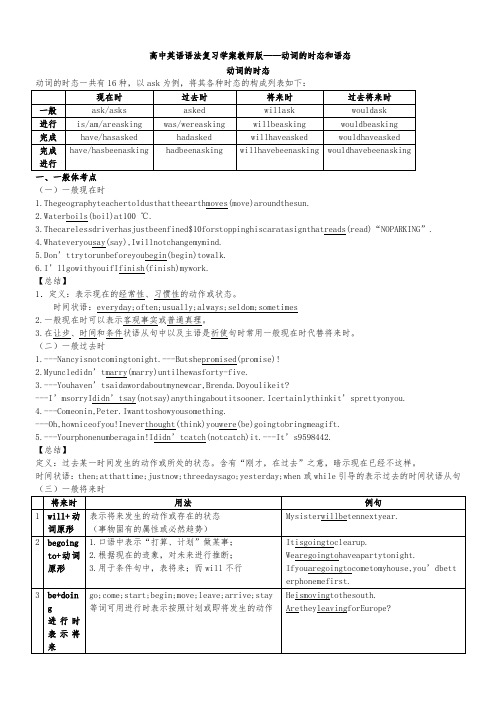
高中英语语法复习学案教师版——动词的时态和语态动词的时态(一)一般现在时1.Thegeographyteachertoldusthattheearthmoves(move)aroundthesun.2.Waterboils(boil)at100 ℃.3.Thecarelessdriverhasjustbeenfined$10forstoppinghiscaratasignthatreads (read)“NOPARKING”.4.Whateveryousay(say),Iwillnotchangemymind. 6.12.3.定义:过去某一时间发生的动作或所处的状态。
含有“刚才,在过去”之意,暗示现在已经不这样。
时间状语:then;atthattime;justnow;threedaysago;yesterday;when 或while 引导的表示过去的时间状语从句【总结】1.定义:将来某一时刻要发生的动作或所处的状态。
时间状语:soon;nextweek;tomorrow等2.beto+动词原形的用法:(1)YouaretodoyourhomeworkbeforeyouwatchTV.=haveto/must“必须“(2)Youaretoreportthepolice.=should/oughtto“应该”7.Selectingamobilephoneforpersonaluseisnoteasytaskbecausetechnologyischanging(change)sorapidly.8.Idon’treallyworkhere.Iamjusthelping(help)outuntilthenewsecretaryarrives.【总结】1.定义1)现在进行时:说话时或现阶段正在发生的动作或存在的状态。
2)过去进行时:过去某个时刻或阶段正在发生的动作或存在的状态。
2.时间状语1)现在进行时:now;rightnow等2)过去进行时:atthistimeyesterday等3.一个长动作为背景,被一个短动作打断,长动作用进行体,短动作用一般体。
动词的时态语态

情态动词 could, would,例如: Could you lend me your bike? 4 用在条件句中表示与现在或将来事实不符的虚 拟语气。 If I were a bird, I would fly to Beijing. If he were here now, we could turn to him for help.
6、某些以主动形式表被动意义的动词的用法。
一般现在时 时 间 状 语 : always, usually, often, sometimes, every week (day, year, month…), once a week, on Sundays, etc. 基本结构:①be动词; ②行为动词 否定形式:①am/is/are+not; ②此时态的谓语 动词若为行为动词,则在其前加don„t,如 主语 为第三人称单数,则用doesn't,同时还原行为 动词。 一般疑问句:①把be动词放于句首;②用助 动词do提问,如主语为第三人称单数,则用 does,同时,还原行为动词。
一般过去时
时间状语:ago, yesterday, the day before yesterday, last week(year, night, month…), in 1989, just now, at the age of 5, one day, long long ago, once upon a time, etc. 基本结构:①be动词的过去式; ②行为动词的过 去式 否定形式:①was/were+not; ②在行为动词前加 didn„t,同时还原 行为动词。 一般疑问句:①was或were放于句首;②用助动词do 的过去式did 提问,同时还原行为动词。
高考英语总复习学案高考语法专题动词的时态和语态新人教版

高考语法专题:动词的时态和语态1. 一般现在时(do, does, am, is, are)(1) 表示经常性、习惯性的动作或现在的状态、特征和普遍真理,一般不表示一个具体的动作。
常用often, usually, always, sometimes, every day 等。
Light travels faster tha n sound.(2) 表示按规定、计划或安排要发生的情况(这种用法只限于beg in, come, go, leave, arrive, stop, start, ope n 等少数动词): The train leaves at 10 a.m..(3) 表示现在进行时:There goes the bell.Here comes the bus.(4) 在时间和条件状语从句中表示将来:You will catch the train if you hurry up.2. 一般过去时(did, was, were)(1) 表示过去发生的动作、存在的状态或习惯性动作,只表过去,与现在无关。
Who broke the wi ndow?(2) 表示客气,与过去时无关:Would/Could you please give me a hand?3. 一般将来时表示说话时看来将要发生的动作或情况,有多种表达方式:(1) shall(will)do:We will meet you at the airport.(2) be goi ng to do, 打算、准备干;即将发生:Come out! The roof is going to fall.( 此处不用will fall)(3) be to do,按计划、安排发生:They are to hand in their pla n n ext week.(4) be about to do, 就要干某事,不与时间状语连用:We are about to leave.(5) be doi ng,用现在进行时表示按规定、计划或安排要发生的情况:We are leav ing for Beiji ng tomorrow.4. 现在进行时(am/is/are doing) 表示说话时正在进行的动作,与now 连用:They are liste ning to music now.5. 过去进行时(was/were doing)表示过去某时正在进行的动作,动作没有完成:At that time he was working in a laboratory.注意:与一般过去时的区别:He was read ing a no vel last ni ght.( 正在读,没读完)He read a novel last night.( 读完了)6. 现在完成时(have/has done)(1)动作发生在过去,但对现在有影响,与already, just, ever, yet,before, rece ntly 等连用,谓语用瞬间动词:Who has opened the door?( 含义:The door was opened. It isstill open. It ' s cold.)(2) 动作从过去某时开始,一直持续到现在,与for, since 或sofar, these days, in the past five years 连用,谓语用延续性动词:I have been in Beijing for half a month.( 不能用have come, 但可说:He has already come.)(3) 过去动作到现在为的总和。
高中英语《动词时态与语态总结》教案
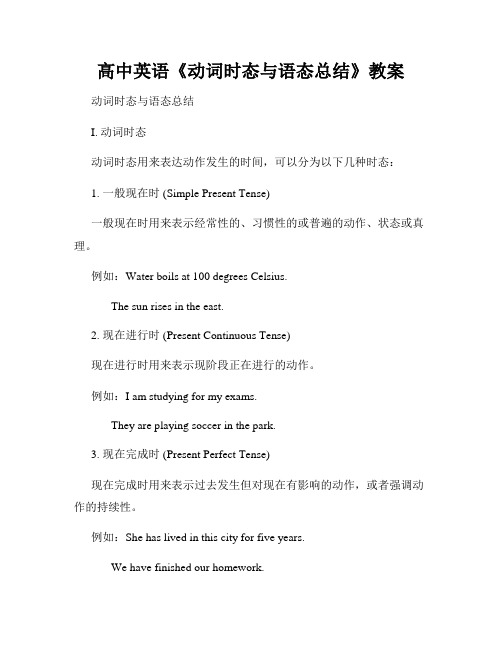
高中英语《动词时态与语态总结》教案动词时态与语态总结I. 动词时态动词时态用来表达动作发生的时间,可以分为以下几种时态:1. 一般现在时 (Simple Present Tense)一般现在时用来表示经常性的、习惯性的或普遍的动作、状态或真理。
例如:Water boils at 100 degrees Celsius.The sun rises in the east.2. 现在进行时 (Present Continuous Tense)现在进行时用来表示现阶段正在进行的动作。
例如:I am studying for my exams.They are playing soccer in the park.3. 现在完成时 (Present Perfect Tense)现在完成时用来表示过去发生但对现在有影响的动作,或者强调动作的持续性。
例如:She has lived in this city for five years.We have finished our homework.4. 一般过去时 (Simple Past Tense)一般过去时用来表示发生在过去的某个具体时间的动作或状态。
例如:I visited my grandparents last weekend.They studied together in college.5. 过去进行时 (Past Continuous Tense)过去进行时用来表示过去某个时间段内正在进行的动作。
例如:She was watching a movie when I called her.They were playing basketball yesterday.6. 过去完成时 (Past Perfect Tense)过去完成时用来表示过去某个时间点之前已经发生的动作或状态。
例如:He had already eaten dinner when I arrived.They had finished the project before the deadline.7. 将来时 (Future Tense)将来时用来表示将要发生的动作或状态。
高考英语一轮复习 动词的时态和语态导学案 北师大版

动词的时态和语态一、动词时态的用法1.一般现在时(1)由连词if,unless,however等引导的时间(条件、让步)状语从句,需用一般现在时表将来。
However much advice you give him,he will do exactly what he wants.(2)安排或计划要做的动作(有时间状语)限于begin,come,leave,go,arrive等一类动词。
I arrive in Beijing at 3∶00 p.m.tomorrow.2.一般过去时过去一段时间内经常或反复发生的行为,常与every day,often,sometimes等时间状语连用。
I used to play football when I was young.3.一般将来时(1)will+do表示将来的动作或状态,常与一些表示将来的时间状语连用;或表示事物的固有属性或必然趋势。
Fish will die without water.(2)be going to+do表示即将发生的或最近打算进行的事。
此外还表示根据现在的迹象,对未来进行推测。
Look at the clouds.It is going to rain.(3)be about to+do表示即将发生的动作,意为“正要;很快,马上”。
后面一般不跟具体的时间状语,但是可以由when连接一个并列句。
We are about to leave.(4)be to+do表示事先商定、安排或准备要做的事情;还表示可能性、必要、责任、义务、禁止等。
She is to get married next month.(5)用现在进行时表示将来。
表示位置转移的动词(go,come,leave,start,arrive等),可用现在进行时表示将来。
Uncle Wang is coming.4.现在进行时表示说话人对主语的行为表示赞叹或厌恶等感情色彩,常与always,constantly,continually等副词连用。
高考英语总复习时态专题学案
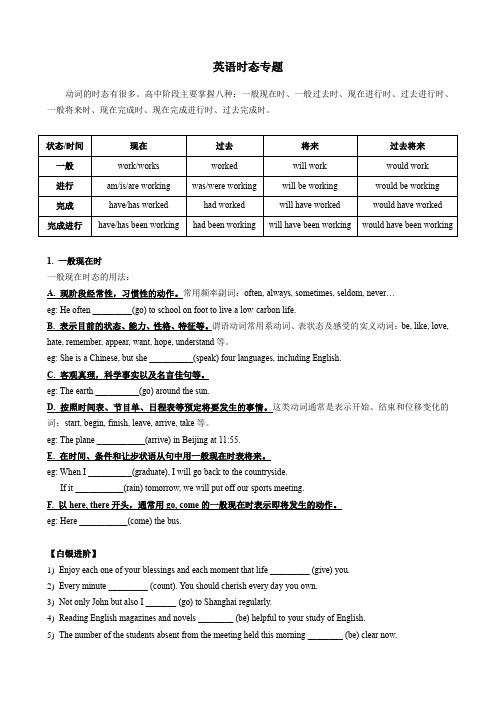
英语时态专题动词的时态有很多。
高中阶段主要掌握八种:一般现在时、一般过去时、现在进行时、过去进行时、一般将来时、现在完成时、现在完成进行时、过去完成时。
1. 一般现在时一般现在时态的用法:A. 现阶段经常性,习惯性的动作。
常用频率副词:often, always, sometimes, seldom, never…eg: He often _________(go) to school on foot to live a low-carbon life.B. 表示目前的状态、能力、性格、特征等。
谓语动词常用系动词、表状态及感受的实义动词:be, like, love, hate, remember, appear, want, hope, understand等。
eg: She is a Chinese, but she __________(speak) four languages, including English.C. 客观真理,科学事实以及名言佳句等。
eg: The earth __________(go) around the sun.D. 按照时间表、节目单、日程表等预定将要发生的事情。
这类动词通常是表示开始、结束和位移变化的词:start, begin, finish, leave, arrive, take等。
eg: The plane ___________(arrive) in Beijing at 11:55.E. 在时间、条件和让步状语从句中用一般现在时表将来。
eg: When I __________(graduate), I will go back to the countryside.If it ___________(rain) tomorrow, we will put off our sports meeting.F. 以here, there开头,通常用go, come的一般现在时表示即将发生的动作。
动词时态和语态复习教案
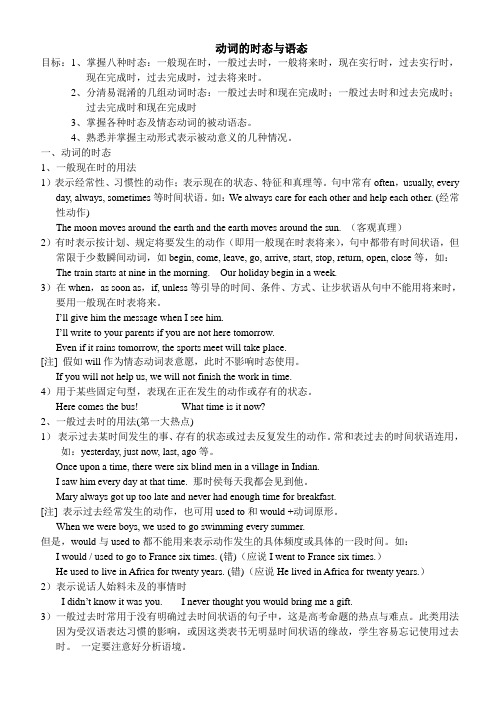
动词的时态与语态目标:1、掌握八种时态:一般现在时,一般过去时,一般将来时,现在实行时,过去实行时,现在完成时,过去完成时,过去将来时。
2、分清易混淆的几组动词时态:一般过去时和现在完成时;一般过去时和过去完成时;过去完成时和现在完成时3、掌握各种时态及情态动词的被动语态。
4、熟悉并掌握主动形式表示被动意义的几种情况。
一、动词的时态1、一般现在时的用法1)表示经常性、习惯性的动作;表示现在的状态、特征和真理等。
句中常有often,usually, every day, always, sometimes等时间状语。
如:We always care for each other and help each other. (经常性动作)The moon moves around the earth and the earth moves around the sun. (客观真理)2)有时表示按计划、规定将要发生的动作(即用一般现在时表将来),句中都带有时间状语,但常限于少数瞬间动词,如begin, come, leave, go, arrive, start, stop, return, open, close等,如:The train starts at nine in the morning. Our holiday begin in a week.3)在when,as soon as,if, unless等引导的时间、条件、方式、让步状语从句中不能用将来时,要用一般现在时表将来。
I’ll give him the message when I see him.I’ll write to your parents if you are not here tomorrow.Even if it rains tomorrow, the sports meet will take place.[注] 假如will作为情态动词表意愿,此时不影响时态使用。
- 1、下载文档前请自行甄别文档内容的完整性,平台不提供额外的编辑、内容补充、找答案等附加服务。
- 2、"仅部分预览"的文档,不可在线预览部分如存在完整性等问题,可反馈申请退款(可完整预览的文档不适用该条件!)。
- 3、如文档侵犯您的权益,请联系客服反馈,我们会尽快为您处理(人工客服工作时间:9:00-18:30)。
动词的时态和语态一动词的时态的分类:一般现在时,一般过去时,一般将来时,现在进行时,现在完成时,过去进行时,过去完成时,过去将来时二用法:1、一般现在时主要用来表示人、事物的现在状况和特点;表示经常或习惯性的动作,句子中常有often, always, from time to time 等时间状语;表示客观规律和永恒真理等。
考点一:表示永恒的真理,即使出现在过去的语境中,仍用一般现在时。
如:I learned that the earth goes around the sun when I was in primary school.考点二:在时间和条件状语从句中,代替一般将来时;常用的引导词有:时间:when, until, after, before, as soon as, once, the moment/the minute, the day; 条件:if, unless, provided.考点三:在make sure (certain), see to it, mind, care, matter +宾语从句,从句用一般现在时代替一般将来时。
So long as he works hard, I don’t mind when he finishes the experiment.只要他努力工作,我不介意他什么时候做完试验。
考点四:在the more… the more … (越……越……)句型中, 若主句是一般将来时, 从句通常用一般现在时。
The harder you study, the better results you will get.2、现在进行时表说话时或目前一段时间内正在进行的活动:或表感情色彩,加强语气。
与频率副词,如always,constantly,continually,again等连用表示说话人的某种感情色彩(赞叹、厌烦、埋怨等)。
考点一:在时间状语或条件状语从句中表示将来正在进行的动作。
Look out when you are crossing the street.考点二:表示在最近按计划或安排要进行的动作(这时多有表示将来的时间状语)。
Marry is leaving on Friday.3、现在完成时表示动作发生在过去,完成在过去,但强调与现在情况仍有联系,其结果或影响仍存在。
现在完成时有一些标志性的时间状语:考点一:for + 时间段;since + 时间点They have lived in Beijing for five years.They have lived in Beijing since 1995.考点二:常见的不确定的时间状语:lately; recently, just, already, yet, up to now; till now; so far, these days,Has it stopped raining yet ?考点三:在表示“最近几世纪/ 年/ 月以来……”时间状语中,谓语动词用现在完成时。
in the past few years/months/weeks/days;over the past few years; during the last three months; for the last few centuries, through centuries; throughout history 等考点四:表示“第几次做某事,”或在“It is the best (worst, most interesting ) +名词+that”后面跟现在完成时。
This is my first time that I have visited China.4.一般过去时表在过去某个特定时间发生且完成的动作,或过去习惯性动作,不强调对现在的影响,只说明过去。
常跟明确的过去时间连用,如:yesterday; last week; in 1945, at that time; once; during the war; before; a few days ago; when, 注意:考点一:used to + do,表示过去经常但现在已不再维持的习惯动作。
to为不定式,后接动词原形。
be/become/get used to + doing,表示习惯于考点二:在时间和条件状语从句中,代替过去将来时。
He promised to buy me a computer if he got a raise5. 过去进行时表示过去某个时间点或某段时间内正在发生的动作。
The boy was doing his homework when his father came back from work.6. 过去完成时表示过去某个时间之前已经完成的动作,即过去完成时的动作发生在“过去的过去”,句中有明显的参照动作或时间状语,这种时态从来不孤立使用 ( before, after, by, up till )By the end of last term we had finished the book.考点一:用于hardly/scarcely...when; no sooner ...than 句型中,主句用过去完成时,从句用一般过去时。
No sooner had I arrived home than the telephone rang. (注意主谓倒装)考点二:表示“第几次做某事”,主句用过去时,从句用过去完成时。
That was the second time that she had seen her grandfather.考点三:动词hope, expect, think, intend, mean, want, suppose, plan 用过去完成时,表示未实现的愿望、打算和意图。
I had hoped that I could do the job.I had intended to see you but I was too busy.7. 一般将来时表在将来某个时间会发生的动作或情况。
常和tomorrow, next year, in 2008等表示将来的时间状语连用,其表现形式多达5种。
Beijing will host the 29th Olympic Games in 2008.考点一:一般将来时总是用在一些时间状语从句或条件状语从句的主句中:We will begin our class as soon as the teacher comes.(主句用一般将来时,从句中一定要用一般现在时替代一般将来时。
)考点二:某些表示短暂性动作的动词如arrive, come, go, leave, start等,用现在进行时形式表示将来。
I am leaving for Beijing tomorrow.考点三:“祈使句 + and/or + 句子”,这种结构中and后面的句子谓语用一般将来时。
Use your head and you will find a way.考点四:“am (is, are) going to +动词原形”,表示打算要做的事或可能要发生的事。
“am (is, are) about to +动词原形”表示按照预定计划或打算准备着手进行的动作。
“am (is, are) to +动词原形”表示必须、必然或计划将要做的事。
They are to be married in this May.8、将来进行时表将来某个时间正在发生的动作,或按计划一定会发生的事情。
I’ll be doing my homework this time tomorrow.明天这会我正在写作业。
9、将来完成时表在将来某时刻之前业已完成的事情,时间状语非常明显。
考点一:常用的时间状语一般用by+将来的时间。
如:by the end of this year, by 8 o’clock this evening, by March next year以及由by the time…, before或when等引导的副词从句。
By the end of next month, he will have traveled 1000 miles on foot.By the time you reach the station, the train will have left.By next Tuesday, I will have got ready for the exams.考点二:在时间和条件状语从句中,将来完成时则由现在完成时表示。
The children will do their homework the moment they have arrived back from school.10. 动词的语态一般用于强调受者,做题时谓语动词不再有名词或宾语。
动词的语态一般不单独考,而是和时态、语气和非谓语动词一起考,只是需要注意以下考点。
考点一:不能用于被动语态的动词和词组come true, consist of, take place, happen, become, rise, occur, belong, break out, appear, arrive, die, fall, last, exist, fail, succeedIt took place before liberation.考点二:下列动词的主动语态表示被动意义, 而且常与well, quite, easily, badly等副词连用。
lock ( 锁 ) ; wash ( 洗 ); sell ( 卖 ); read ( 读 ); wear ( 穿 ); blame (责备);ride (乘坐);write ( 写 );Glass breaks easily. 玻璃容易破碎。
考点三:一些常用经典被动句型:It is said…, It is reported…, It is widely believed…,It is expected…, It is estimated…,这些句子一般翻译为“据说……”,“人们认为……”,三高考真题1. (2005山东卷) With more forests being destroyed, huge quantities of good earth ______ each year.A. is washing awayB. is being washed awayC. are washing awayD. are being washed away2. (2006山东卷) Although the causes of cancer ____, we do not yet have any practical way to prevent it.A. are being uncoveredB. have been uncoveringC. areuncovering D. have uncovered3. (2007山东卷) They_____ two free tickets to Canada, otherwise they’d never have been able to afford to go.A. had gotB. gotC. have gotD. get4. (2008山东卷) By the time he realizes he ______ into a trap, it’ll be too late for him to do anything about it.A. walksB. walkedC. has walkedD. had walked5.(2009山东卷)The number of foreign students attending Chinese universities _____ rising steadily since1990.A. isB. areC. has beenD. have been6.(2009山东卷)I was out of town at the time, so I don’t know exactly how it _______.A. was happeningB. happenedC. happensD. has happened7.(2010山东卷)Up to now, the program ______thousands of children who would otherwise have died.A. would saveB. savesC. had savedD. has saved 8.(2011·山东卷)When I got on the bus, I_____I had left my wallet at home.A.was realizing B.realized C.have realized D.would realize 9.(2011·山东卷)She was surprised to find the fridge empty; the child _____ everything!A.had been eating B.had eaten C.have eaten D.have been eating10. (2012山东卷) After Jack had sent some e—mails, he _______ working on his project.A. had startedB. has startedC. startedD. starts11. (2012山东卷) The manager was concerned to hear that two of his trusted workers ______.A. will leaveB. are leavingC. have leftD. were leaving14. (2012山东卷) If we _______ adequate preparations, the conference wouldn’t have been so successful.A. haven’t madeB. wouldn’t makeC. didn’t makeD. hadn’t made15. (2013山东卷)I didn’t think I’d like the movie, but actually it _____ pretty good.A. has beenB. wasC. had beenD. would be16.(2013山东卷)—Oh no! We’re too late. The train _______.—That’s Ok. We’ll catch the next train to London.A. was leavingB. had leftC. has leftD. has been leaving17.(2010全国)-----Have you finished reading Jane Eyre?-----No, I_________ my homework all day yesterday.A. was doingB. would doC. had doneD. do18. (2010全国I 32).The discovery of gold in Australia led thousands to believe that a fortune _______.A. is madeB. would makeC. was to be madeD. had made19.(2010全国II 19). Excuse me. I _____ I was blocking your way.A. didn’t realizeB. don’t realizeC. haven’t realizedD. wasn’t realizing20. (2010安徽卷26).Bob would have helped us yesterday ,but he .A. was busyB. is busyC. had been busyD. will be busy 21.(2011·天津卷)On the next birthday, Ann married for twenty years.A.is B.has been C.will be D.will have been 22.(2011·天津卷)In the last few years thousands of films allover the word.A.have produced B.have been produced C.are producing D.are being produced23.(2012江西卷)—Look! Somebody the sofa.—Well, it wasn’t me. I didn’t do it.A.is cleaning B.was cleaning C.has cleaned D.had cleaned24.(2011·北京卷)—That must have been a long trip.—Yeah, it us a whole week to get there.A.takes B.has taken C.took D.was taking 25.(2011·北京)Maybe if I science, and not literature then, I would be able to give you more help.A.studied B.would study C.had studied D.was studying26.(2011·辽宁卷)I'll go to the library as soon as I finish what I . A.was doing B.am doing C.have done D.had been doing27.(2011·辽宁卷)By the time Jack returned home from England, his son from college.A.graduated B.has graduated C.had been D.had graduated 28. (2012全国卷II)18. The manager ___ the workers how to improve the program since 9 a.m.A. has toldB. is tellingC. has been tellingD. will have told29. (2012北京卷)25. George said that he would come to school to see me the next day, but he ______.A. wouldn’tB. didn’tC. hasn’tD. hadn’t30. (2012重庆) Food supplies in the flood—stricken area ________. We must act immediately before there’s none left.A. have run outB. are running outC. have been run outD. are being run out。
